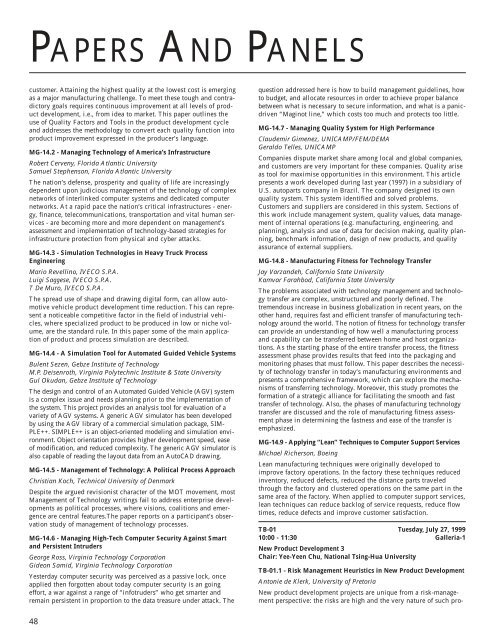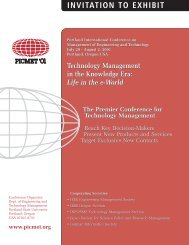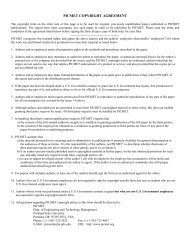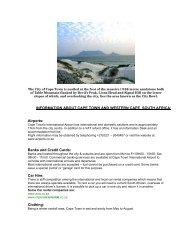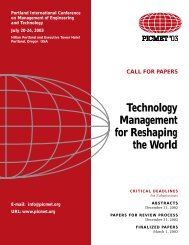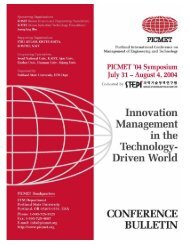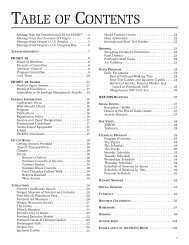Technology & Innovation Management: - PICMET Conference
Technology & Innovation Management: - PICMET Conference
Technology & Innovation Management: - PICMET Conference
Create successful ePaper yourself
Turn your PDF publications into a flip-book with our unique Google optimized e-Paper software.
PAPERS AND PANELS<br />
customer. Attaining the highest quality at the lowest cost is emerging<br />
as a major manufacturing challenge. To meet these tough and contradictory<br />
goals requires continuous improvement at all levels of product<br />
development, i.e., from idea to market. This paper outlines the<br />
use of Quality Factors and Tools in the product development cycle<br />
and addresses the methodology to convert each quality function into<br />
product improvement expressed in the producer’s language.<br />
MG-14.2 - Managing <strong>Technology</strong> of America’s Infrastructure<br />
Robert Cerveny, Florida Atlantic University<br />
Samuel Stephenson, Florida Atlantic University<br />
The nation’s defense, prosperity and quality of life are increasingly<br />
dependent upon judicious management of the technology of complex<br />
networks of interlinked computer systems and dedicated computer<br />
networks. At a rapid pace the nation’s critical infrastructures - energy,<br />
finance, telecommunications, transportation and vital human services<br />
- are becoming more and more dependent on management’s<br />
assessment and implementation of technology-based strategies for<br />
infrastructure protection from physical and cyber attacks.<br />
MG-14.3 - Simulation Technologies in Heavy Truck Process<br />
Engineering<br />
Mario Revellino, IVECO S.P.A.<br />
Luigi Saggese, IVECO S.P.A.<br />
T De Muro, IVECO S.P.A.<br />
The spread use of shape and drawing digital form, can allow automotive<br />
vehicle product development time reduction. This can represent<br />
a noticeable competitive factor in the field of industrial vehicles,<br />
where specialized product to be produced in low or niche volume,<br />
are the standard rule. In this paper some of the main application<br />
of product and process simulation are described.<br />
MG-14.4 - A Simulation Tool for Automated Guided Vehicle Systems<br />
Bulent Sezen, Gebze Institute of <strong>Technology</strong><br />
M.P. Deisenroth, Virginia Polytechnic Institute & State University<br />
Gul Okudan, Gebze Institute of <strong>Technology</strong><br />
The design and control of an Automated Guided Vehicle (AGV) system<br />
is a complex issue and needs planning prior to the implementation of<br />
the system. This project provides an analysis tool for evaluation of a<br />
variety of AGV systems. A generic AGV simulator has been developed<br />
by using the AGV library of a commercial simulation package, SIM-<br />
PLE++. SIMPLE++ is an object-oriented modeling and simulation environment.<br />
Object orientation provides higher development speed, ease<br />
of modification, and reduced complexity. The generic AGV simulator is<br />
also capable of reading the layout data from an AutoCAD drawing.<br />
MG-14.5 - <strong>Management</strong> of <strong>Technology</strong>: A Political Process Approach<br />
Christian Koch, Technical University of Denmark<br />
Despite the argued revisionist character of the MOT movement, most<br />
<strong>Management</strong> of <strong>Technology</strong> writings fail to address enterprise developments<br />
as political processes, where visions, coalitions and emergence<br />
are central features.The paper reports on a participant’s observation<br />
study of management of technology processes.<br />
MG-14.6 - Managing High-Tech Computer Security Against Smart<br />
and Persistent Intruders<br />
George Ross, Virginia <strong>Technology</strong> Corporation<br />
Gideon Samid, Virginia <strong>Technology</strong> Corporation<br />
Yesterday computer security was perceived as a passive lock, once<br />
applied then forgotten about today computer security is an going<br />
effort, a war against a range of “infotruders” who get smarter and<br />
remain persistent in proportion to the data treasure under attack. The<br />
question addressed here is how to build management guidelines, how<br />
to budget, and allocate resources in order to achieve proper balance<br />
between what is necessary to secure information, and what is a panicdriven<br />
“Maginot line,” which costs too much and protects too little.<br />
MG-14.7 - Managing Quality System for High Performance<br />
Claudemir Gimenez, UNICAMP/FEM/DEMA<br />
Geraldo Telles, UNICAMP<br />
Companies dispute market share among local and global companies,<br />
and customers are very important for these companies. Quality arise<br />
as tool for maximise opportunities in this environment. This article<br />
presents a work developed during last year (1997) in a subsidiary of<br />
U.S. autoparts company in Brazil. The company designed its own<br />
quality system. This system identified and solved problems.<br />
Customers and suppliers are considered in this system. Sections of<br />
this work include management system, quality values, data management<br />
of internal operations (e.g. manufacturing, engineering, and<br />
planning), analysis and use of data for decision making, quality planning,<br />
benchmark information, design of new products, and quality<br />
assurance of external suppliers.<br />
MG-14.8 - Manufacturing Fitness for <strong>Technology</strong> Transfer<br />
Jay Varzandeh, California State University<br />
Kamvar Farahbod, California State University<br />
The problems associated with technology management and technology<br />
transfer are complex, unstructured and poorly defined. The<br />
tremendous increase in business globalization in recent years, on the<br />
other hand, requires fast and efficient transfer of manufacturing technology<br />
around the world. The notion of fitness for technology transfer<br />
can provide an understanding of how well a manufacturing process<br />
and capability can be transferred between home and host organizations.<br />
As the starting phase of the entire transfer process, the fitness<br />
assessment phase provides results that feed into the packaging and<br />
monitoring phases that must follow. This paper describes the necessity<br />
of technology transfer in today’s manufacturing environments and<br />
presents a comprehensive framework, which can explore the mechanisms<br />
of transferring technology. Moreover, this study promotes the<br />
formation of a strategic alliance for facilitating the smooth and fast<br />
transfer of technology. Also, the phases of manufacturing technology<br />
transfer are discussed and the role of manufacturing fitness assessment<br />
phase in determining the fastness and ease of the transfer is<br />
emphasized.<br />
MG-14.9 - Applying “Lean” Techniques to Computer Support Services<br />
Michael Richerson, Boeing<br />
Lean manufacturing techniques were originally developed to<br />
improve factory operations. In the factory these techniques reduced<br />
inventory, reduced defects, reduced the distance parts traveled<br />
through the factory and clustered operations on the same part in the<br />
same area of the factory. When applied to computer support services,<br />
lean techniques can reduce backlog of service requests, reduce flow<br />
times, reduce defects and improve customer satisfaction.<br />
TB-01 Tuesday, July 27, 1999<br />
10:00 - 11:30 Galleria-1<br />
New Product Development 3<br />
Chair: Yee-Yeen Chu, National Tsing-Hua University<br />
TB-01.1 - Risk <strong>Management</strong> Heuristics in New Product Development<br />
Antonie de Klerk, University of Pretoria<br />
New product development projects are unique from a risk-management<br />
perspective: the risks are high and the very nature of such pro-<br />
48


